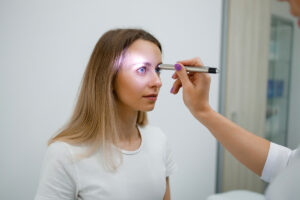Causes, Symptoms, and Treatment
 Our eyes are our window to the world. But they’re delicate and easily subject to injury. Most eye injuries can be treated, but prompt care is essential. Let’s take a look at the most common eye injuries, how to tell if you need to seek care, and the different types of treatment available.
Our eyes are our window to the world. But they’re delicate and easily subject to injury. Most eye injuries can be treated, but prompt care is essential. Let’s take a look at the most common eye injuries, how to tell if you need to seek care, and the different types of treatment available.
What Are the Most Frequent Types of Trauma Involving the Eye?
Here are the most common reasons people seek medical care for their eyes:
- Retinal detachment—One of the most common eye injuries, a detached retina can lead to blindness if not properly treated. The retina plays a key role in sending signals from your optic nerves to your brain.
- Foreign objects in or on the eye—Though your eyelids can move quickly and protect you from flying objects, you can still be at risk whenever there’s debris in the air. Often, when conditions are windy, dust or other mobile objects can land on the surface of your eye or even penetrate it.
- Corneal abrasions—Those flying objects can scratch or even lodge in your cornea, the clear transparent matter in the front of your eyeball
- Hemorrhaging in the eye—A corneal abrasion or penetration can break blood vessels in the eye, but so can overexertion. A sneeze or cough can break a blood vessel in your eye, as can the impact of a blow, even if your eye is closed.
- Burning or irritation in the eye—Chemical fumes are a common cause of burning or irritated eyes.
- Black eye—Though not technically an eye injury, a black eye can lead to swelling that impairs vision. The discoloration typically associated with a black eye comes from damage to tissue around the eye.
- Orbital fractures—The eyes are protected by hard bone in the skull. A hard blow to the orbital bone, or eye socket, can cause the bone to shatter, compromising the integrity of the muscles that hold the eye in place.
How to Recognize If You’ve Suffered an Eye Injury
The telltale signs that you need medical attention after an eye injury include:
- Pain, puffiness, or swelling in or around your eye
- Changes in your vision, including blurring, double vision, haloing, floaters, or flashes of light
- Redness or bleeding in any part of your eye
- Difficulty moving your eyes up and down or side to side, including pain when trying to do so
- A visible difference in the appearance of one eye—for example, a larger or smaller pupil, lack of focus, or discoloration
Treatment Options for Eye Injuries
For any serious eye injury, you should immediately schedule an appointment with an ophthalmologist. In some situations, such as with a detached retina, surgery may be required.
For minor eye injuries, and to obtain some relief until you see an eye doctor, you can:
- Apply a cold compress to reduce swelling and alleviate pain
- Use prescription eye drops to facilitate healing
- Flush your eye with clean water
- Protect your eye from further injury with an eye patch

